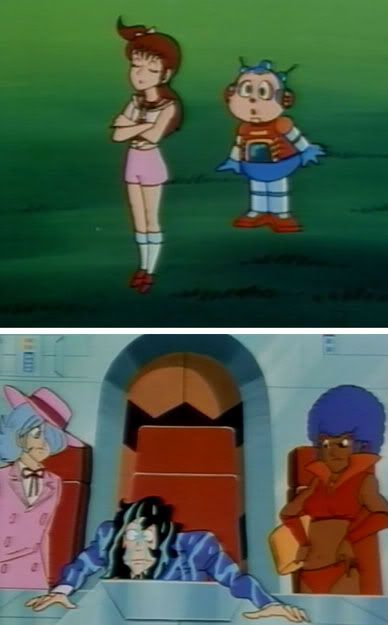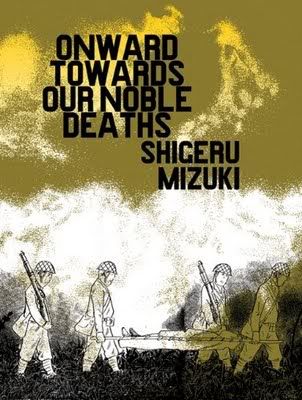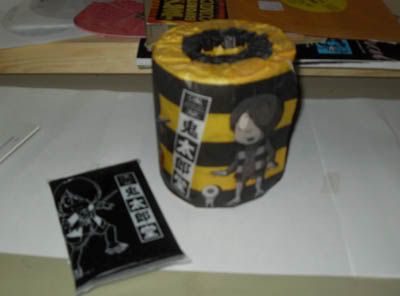Back in the feral prehistory of anime fandom, seekers would brave the darkest recesses of that most foetid pit of darkness- the children’s section of the video store. There, amongst the clamshelled remains of Walt Disney, would reside the sole representatives of the Japanese anime industry deemed worthy to compete in the American home video market. These were the days before AnimEigo would pioneer the field of uncut direct-to-video anime releases, so our choices were Jim Terry’s FORCE FIVE series of giant robot slugfests, maybe a few Family Home Entertainment’s abortive ROBOTECH releases, and a scattering of Z.I.V. versions of shows that deserved better treatment, like CAPTAIN HARLOCK or CANDY CANDY.
And of course we had NINJA THE WONDER BOY. Ah, NINJA THE WONDER BOY. Rolls off the tongue, doesn’t it? This remarkably inept piece of junk found its way into the tape collections of most Reagan-era anime fans. Not because it was good - far from it – but because by God, it was an anime title, and we were anime fans, and therefore we had to embrace it like a recently paroled cousin. Apart from providing fodder for Corn Pone Flicks documentary series BAD AMERICAN DUBBING, NINJA THE WONDER BOY served only as a Ninja The Whipping Boy for the sarcastic amusement of jaded anime fans seeking what we’d later term “totally lame anime”.
But confusion lingered around NINJA THE WONDER BOY. Sure, it was dubbed by legendary kidvid localizer Jim Terry Productions, who gave us not only the FORCE FIVE family of super-robots like GRANDIZER and DANGUARD ACE, but also voiced Tatsunoko’s TIME BOKAN as TIMEFIGHTERS, produced a very edited English CRUSHERS dub of the CRUSHER JOE movie, and brought forth the dub of Toei’s KING ARTHUR. Dubbing is, however, only half the story. Who animated this piece of ninja junk anyway? Was it in fact one of those crazy Korean knockoffs like GOLDWING or DEFENDERS OF THE SPACE? Or was it an honest-to God Japanese cartoon from Japan? Careful examination of the Jim Terry credits led me to the production company - Knack Studio.
As it turns out Knack has the dubious honor of being the driving force behind some of the worst Japanese cartoons ever produced. If they weren’t ruining Japan’s martial heritage with NINJA THE WONDER BOY (MANGA SARUTOBI SASUKE), they were cluttering up the giant robot field with turkeys like ASTROGANGER and GROIZER X or diluting the children’s comedy anime market with CYBOT ROBOTCHI (American title ROBBY THE RASCAL). Not to mention despoiling the memory of beloved live-action heroes with their versions of MITOKOMON and GEKKO KAMEN (“Moonlight Mask”, not the naked Go Nagai one). Most of their productions share the Knack hallmarks of shoddy, barely-there animation and characters, themes, and mechanical designs suspiciously similar to other, more popular shows. That’s not to say that everything they did was terrible, but the Japanese animation field is a big one and somebody’s got to be near the bottom, that’s just how things shake out.

artwork by Knack staffer Seiichi Hayashi
Knack (now called Ichi Corporation) was started in 1967 by former Mushi Productions and Toei staff, including talented, award-winning illustrator Seiichi Hayashi. As a studio they might have had more misses than hits but there was real potential in their lineup. Knack’s earliest show was 1972’s GRIMALKIN, aka “Granny Mischief”, a gag show based on the comic strip by Machiko “Sazae-San” Hasegawa. SAZAE-SAN’s still on the air, while GRIMALKIN is a misty memory. Do the math. It wouldn’t be long before high-profile licenses would give way to more original, less coherent shows.

Astroganger and friend
1972’s ASTROGANGER is a particular favorite; and by “favorite” I mean “favorite to laugh at”. When danger threatens the Earth in the form of sequentially-numbered aliens in flying saucers, our young hero Kantaro brandishes his medallion, instantly changes into a superhero outfit, and is sucked via energy beam into the guts of the clunky-looking robot Astroganger, who then proceeds to smash the aliens. Astroganger talks, feels pain, and makes the audience wonder what the benefit of having a giant robot is if he’s grunting every time some monster takes a swipe at him. Naturally there’s a requisite science center, managed by what appears to be Kentucky Fried Chicken’s Colonel Sanders. ASTROGANGER creatively strip-mined earlier, vastly superior shows like BABEL 2 and TETSUJIN 28, while the rest of the industry was moving on the slightly more sophisticated entertainment of MAZINGER Z style robot action. Character design and key animation for ASTROGANGAR was courtesy Tama Productions’ Eiji Tanaka, who also subcontracted for Tatsunoko Productions, and who also worked on Knack’s 1973 series CHARGE MAN KEN.

Charge Man Ken
As a CASSHAN or a HURRICANE POLIMAR for the preschool set, CHARGE MAN KEN wears its Tatsunoko hero pedigree on its weirdly colored sleeve. But as a piece of cartoon television it carves out its own wildly incomprehensible space, as legions of YouTube viewers have come to know. The show’s inexplicable DVD release sparked an online viewing frenzy as dumbstruck fans shared their newly uncovered, forever lame gem with their friends. Parody subtitles, fan videos, and the kind of enthusiasm usually reserved for, you know, actual entertainment have all appeared in the mighty wake of CHARGE MAN KEN.

Groizer X, Joe, Rita
Knack would return to the super robot field with a disgruntled-with-Toei Go Nagai and 1976’s GROIZER X. When a mysterious girl flying a super space vehicle crashlands on Earth, it’s time for science center layabout hero Joe to take the wheel of her super space vehicle and battle the Gaira aliens. The Groizer X transforms into a super robot with rocket fists and jets of flame, but easily transforms back into jet-airliner configuration to enable it to land safely at any major metropolitan airport. GROIZER X inspired some boss 70s diecast toy action that even saw a brief US release, and the show was a major hit in Brazil.

Cybot Robotichi aka Robby The Rascal
Go Nagai’s frequent collaborator Ken Ishikawa would work on Knack’s CYBOT ROBOTCHI, the tale of an absentminded, lecherous inventor who builds himself a little robot buddy who gets into trouble a lot. Though this is a DR SLUMP ripoff crossed with a ROBOCON swipe, it’s nowhere near as shameless as the American sitcom SMALL WONDER. Fact is, ROBOTCHI gets downright wacky; there’s an entire village of wacky small-town type robots who struggle against the machinations of a spoiled zillionaire and his sexy henchmen. Released in America as ROBBY THE RASCAL, it’s a definite curiosity.

Robby and girlfriend, evil Horatio Horton III and his sexy sidekicks
When KAMEN RIDER was heating up the small screen Knack had to cash in. So they did the next best thing, they licensed Kamen Rider’s spiritual predecessor, GEKKO KAMEN or MOONLIGHT MASK, for a 1972 anime series. Unfortunately capturing the zip and panache of Japan’s tokusatsu heroes in animated form has never been easy, and it’s got to be even more difficult when your studio is Knack and therefore sucks. I saw this show in Spanish on Univision, and unlike fellow Univision series EL NINO DEL FUTURO (FUTURE BOY) CONAN, MOONLIGHT MASK is inept and clumsy, dated even as it aired.

in the name of the moon I will punish you
1979’s NINJA THE WONDER BOY (Manga Sarutobi Sasuke) itself is no prize. Forget contemporary, successful ninja anime series like KAMUI and NINJA SASUKE, with their drama and their expressionistic, gekiga inspired visuals – NINJA THE WONDER BOY looks like Astro Boy in feudal drag. The show’s cartoony designs and kiddy-grade stories are nowhere near Real Ultimate Power when it comes to ninja animation, and while there’s lip service paid to the feudal setting and the historical reality behind the characters, this show also features evil witches, giant dragons, and betting on horse races.

he's a wonder!
In spite of its more questionable creative decisions, Knack managed to knock out a few quality shows and score some international success. Go Nagai returned to Knack for 1983’s PSYCHO ARMOR GOVARIAN, an outerspace super-robot show with an ESP twist; pilot Isamu controls his Psycho Armor with his own psychic power and battles invaders from another dimension. Though similar in appearance to MAZINGER Z, there isn’t any connection between GOVARIAN and the more successful MAZINGER, except in South Korea where GOVARIAN and GROIZER X were released as part of MAZINGER Z.

Psycho Armor Govarian

Don Chuck and friends
Children around the world in 1975 watched and enjoyed DON CHUCK STORIES, a long-running series about a beaver who wears overalls. Germany, Italy, the Arabian world, Russia; they all went nuts for this overall-sporting, strangely yellow beaver and his more than 100 episodes of woodland fun. A more sophisticated anthropomorphisized Knack series was SUE CAT, the story of a cat girl who finds her family and a musical career AND life as a line of character goods.

The 1984 volleyball drama ATTACKER YOU managed to overcome a derivative title with unique and, for Knack, classy character designs. Tomboy You Hazuki arrives at a new school, finds herself on the volleyball team, and struggles with her coach and the hostility of the team’s captain on her way to the Olympics! This series was a big hit in Europe where it was packaged as a sequel to ATTACK NO. 1, even though the two shows had nothing to do with each other. ATTACKER YOU was even popular enough for a 2008 Chinese/Japanese co-produced sequel that starred a kung-fu fighting volleyball girl and went straight to video in Japan.

And when Knack produced THE LITTLE PRINCE in 1978, based on the children’s books by French aviator Antoine St. Expury, they managed to score both domestically and around the world. Early adopters of NICKELODEON will remember THE LITTLE PRINCE fondly along with BELLE AND SEBASTIAN and MYSTERIOUS CITIES OF GOLD, not to mention YOU CAN’T DO THAT ON TELEVISION and the show where they would simply read comic books out loud. What was up with that? At any rate I wrote a whole thing on THE LITTLE PRINCE already so go read that now.

Oh! Family
Knack’s situation-comedy family division would be represented by several different series over the years. 1984’s OH! FAMILY was based on the manga by Taeko Watanabe. OH! FAMILY is the delicate, pastel-colored and very 80s slice-of-life story of Anderson family of Los Angeles, California, whose idyllic family life is disrupted when young Johnathan shows up, claiming to be Dad’s illegitimate child. It’s a far cry from 1974’s NO-GOOD DADDY (Dame Oyaji), the biting, irreverent story of the saddest dad in Japan, disrespected by wife and children alike. Though toned down from the original manga’s bleak cynicism, the show still managed to shock audiences unwilling to look past the icon of the all-powerful Japanese father.
As the anime book of the 80s wound down Knack diversified into live-action films and direct-to-video live productions with titles like Assassin Girl Battle Road, Path Of Shura, New Gangster Kingdom, and something called “Peanuts”. Their animation business continued as they assisted in the production of END OF EVANGELION and their bandwagon-jumping continued as they produced a whole slew of adult-oriented anime videos with titles like SPONGE HEAVEN, TIME FOR ADVENTURE, and SLIGHT FEVER SYNDROME.
But as the internet success of CHARGE MAN KEN shows, their true legacy may very well be that of a studio that solidly filled out the middle-to-lower ranks of the anime world, producing adequate if uninspiring sports and children’s anime along with what-were-they-thinking oddities. So whether you’re a sarcastic mocker of lame anime or a nostalgic basic cable viewer with a fond memory of little princes in outer space, you have only one studio to thank, and that’s Knack.




































